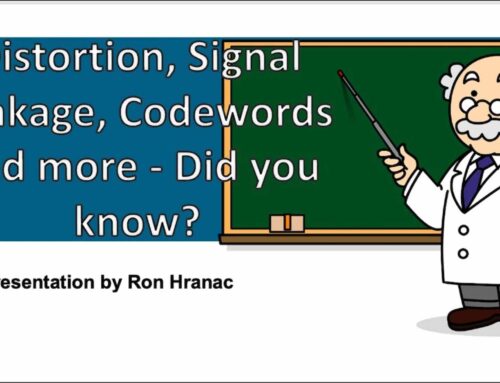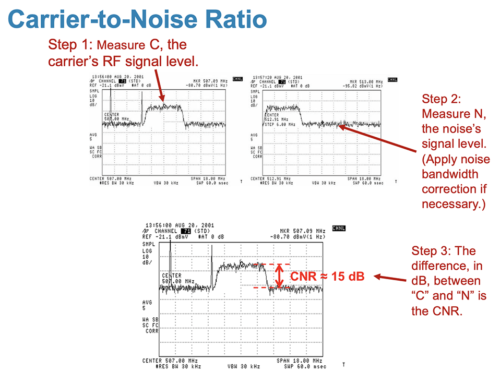In high-speed data communications, the industry has evolved and implemented complex modulation schemes which vary a signal’s voltage (amplitude), phase, and frequency in order to transmit more data, faster. The following will cover these methods in order to describe how Quadrature Amplitude Modulation (QAM) works in DOCSIS communications.
We live in an analog world. Sure, today we are surrounded by “digital” technology and advertisements of “all digital communications”, but the basis of all digital communications is analog as I will explain. Okay, there is the exception in the virtual world of computer software where pure Boolean logic can exist without analog, but when software meets hardware, it becomes analog – a disclaimer for the purists.
TTL (transistor-to-transistor logic) logic circuits have been a fundamental building block of digital circuits since 1961[1]. Digital technology and communications at its primal level is made up of 0’s and 1’s. All data is communicated using these two values. For hardware to transmit a “zero” or a “one”, the hardware “transmitter” must use some means of stimulus such that the hardware “receiver” can differentiate a one from a zero. An example is TTL logic, in which case a zero is represented by any voltage level from 0 to +0.8 Vdc and a one is represented by any voltage level from +2.2 to +5.0 Vdc[2]. Anything greater than +0.8 Vdc and less than +2.2 Vdc is ignored by the receiver. So in this example, a transmitter uses analog voltage to transmit digital data to the receiver.
Signals and Modulations
Fundamentally, every complex signal can be represented by the following equation:
where s(t) is the signal as a function of time (t),
A is the amplitude or voltage of the signal
is, well that’s “pi” and is approximated by 3.14
is the frequency of the signal, in my blog on RF Fundamentals I discussed that the DOCSIS downstream would be between 54 – 1000 MHz, so
could be 500 MHz as an example
is the phase in degrees of the signal
Just like in the TTL example above, if amplitude, frequency or phase is varied in the signal above, data can be transmitted as will be illustrated below.
Amplitude Modulation
Amplitude Modulation (AM) is a method of communicating data when a carrier wave is varied in direct proportion to that of a modulating signal (i.e. baseband digital data).
- What is Amplitude? It is the peak to peak voltage of a signal, “A” in the signal equation.
- In Amplitude Modulation the Amplitude of the signal varies peak to peak
- What is Frequency? The rate of change per second given in Hz. i.e. A radio station always remains at the same frequency. It is constant.
An AM receiver consists primarily of a tunable filter and an envelope detector, which in simpler sets is a single diode. Its output is a signal at the carrier frequency, with peaks that trace the amplitude of the un-modulated signal. Amazingly, this is all that is needed to recover the original audio! In practice, a capacitor is used to undo the DC shift introduced by the transmitter and to eliminate the carrier frequency by connecting the signal peaks. The output is then fed to an audio amplifier.
The figure below shows data (the red line) being “modulated” onto the carrier frequency (green line and f0) from our equation above.The net result is the blue modulated sine wave, which is transmitting the desired data.A device on the receiving end will be able to demodulate the signal and interpret the transmitted data.

Amplitude Modulation
Frequency Modulation
Like amplitude modulation, Frequency Modulation (FM) also has a carrier wave (f0), but the amplitude is kept constant.In order to transmit data in a FM modulation scheme, it is actually f0 that is modulated by the data to be transmitted.The carrier wave frequency is varied in direct proportion to changes in the amplitude of an input signal.
- Frequency of signal varies. In the figure below, the signal peaks are no longer evenly spaced. They are now separated mimicking the signal being imposed on the carrier
- Amplitude of signal is constant. The peak to peak voltage does not change as seen in the graph below
The figure below shows the data (red line) modulating the carrier signal (green line) for a resulting modulated signal (blue line). Notice that the blue signal is a sine wave that has non-constant variations between periods of the sine waves. This is what the signal looks like in the time domain. This indicates that the sine wave is getting faster and slower as the data is “modulating” the sine wave, or as f0 is being modulated.

Frequency Modulation
Phase Modulation
Phase modulation (PM) is a form of modulation which represents information as variations in the instantaneous phase of a carrier wave.
Note:Variation of frequency implies a variation of phase; mathematically these two types of Modulation are complementary through derivatives and integrals.
The figure below shows the data (red) modulating the carrier signal (green).The resulting signal in blue appears similar to frequency modulation as indicated in the “note” above due to the relationship between FM and PM. However, the actual modulation is a change in phase rather than in frequency. Therefore, the receiver is a bit more complex to make than a standard FM receiver.

Phase Modulation
Phase Shift Keying
Phase-shift keying (PSK) is a digital modulation scheme that conveys data by changing, or modulating, the phase of a reference signal (the carrier wave). Any digital modulation scheme uses a finite number of distinct states to represent digital data. In the case of PSK, a finite number of phases are used. Each of these phases is assigned a unique pattern of binary bits. Usually, each phase encodes an equal number of bits. Each pattern of bits forms the symbol that is represented by the particular phase. The demodulator, which is designed specifically for the symbol-set used by the modulator, determines the phase of the received signal and maps it back to the symbol it represents, thus recovering the original data. This requires the receiver to be able to compare the phase of the received signal to a reference signal — such a system is termed coherent.
The figure below shows an example of a PSK system with binary data mapped to the phase shifts of the relevant signal.

Phase Shift Keying Modulation
Complex Modulation
So far, all of the modulation schemes discussed are capable of transmitting data, some at high speeds, but for DOCSIS very high speeds are needed. In order to achieve this, complex modulations are needed which use a combination of he modulations described so far. The modulation used in the DOCSIS downstream is called Quadrature Amplitude Modulation (QAM), pronounced “kwam”. QAM transmits data by changing the amplitude of two carriers simultaneously. Since the two carriers are 90? out of phase, the sum of resulting signals have both level and phase variations. This provides for a large variation of data transition points, adding to the data throughput of a QAM signal. The mathematical formula for a QAM signal is as follows:
A representation of an 8-QAM signal is shown in the following figure.

Complex Modulation
Quadrature Amplitude Modulation (QAM)
So finally we arrive at the conclusion of this blog, which is QAM modulation, specifically 64-QAM and 256-QAM under the J.83 Annex B (Annex A for Europe) standard. These are the two modulations identified in the DOCSIS specification for downstream data transmission. 64-QAM has six (6) bits per symbol, contrasted to the three bits per symbol in the Complex Modulation diagram above shown in the “Complex Modulation” section. 256-QAM has eight bits per symbol. 64-QAM is able to transmit about 30 mega-bits-per second (Mbps) while 256-QAM can transmit about 40 Mbps. Looking at the analog signals in the time domain can be quite messy, so it is common to use a technique called constellation analysis to view these modulations. See the following figures:

64-QAM

256-QAM
Constellation analysis is valuable for viewing high order, complex modulations because it allows one to see how many symbols are present in the modulation, 64 or 256 in the above case, in addition, one can see if impairments are present in the signal, which will be covered later in my posts on DOCSIS Troubleshooting.
Tune in next time when I will cover DOCSIS upstream modulation types, which builds upon this post.
—————————————————————————————————————————————–
[1] Buie, J. Coupling Transistor Logic and Other Circuits. (U.S. Patent 3,283,170). 1 November 1966. United States Patent and Trademark Office. 1 November 1966.
[2] Transistor-Transistor Logic (TTL) siliconfareast.com. 2005. Retrieved 17 September 2008
Upcoming events can be seen under Broadband Events. Previous events can be seen under the blog.
- If you are watching this on youtube please hit the subscribe button!
- Let us know what you think and remember to share!
- You can find slides at the bottom of the page and some on slideshare.
- Find out about events or articles by following us on Twitter, LinkedIn or Facebook too.
Also available on iTunes, Google Podcasts, Spotify, vurbl see podcasts “get your tech on”.




Awesome post. I was looking at setting up the same info on my site when I found this page. Going to add a link on my site to point over to this post now and save myself a lot of trouble, if that’s ok.
This blog is really very helpful to understand the signalling concepts in a layman way.
Great Job….
Keep going.
Franz,
Thanks for the eye on the typos. One of these days I will find the time to get back on the DOCSIS 3.0 tutorial and fix the typos and errors you caught. I always appreciate critical feedback. When writing, it is amazing what one’s brain fails to translate to one’s hands. 😉
Regards,
-Brady
So glad I stumbled upon this! I am new to all this but I am little bit confuse by the first point you made. Nevertheless, these are good suggestions!
Great site Brady!
>
I’m hoping you can answer a couple of questions relating to DOCSIS channel spacings within the RF spectrum?
>
Firstly, I understand that the downstream utlises the 108MHz to 862MHz, using 8MHz channels (EuroDOCSIS) and upstream utilising the 5MHz to 65MHz, using upto 6.4MHz channel bandwidths. I would like to know what degree of separation (i.e. frequency gap) exists between each adjacent channel in botht he upstream and downstream direction as I cannot seem to find this referenced anywhere?
>
Secondly, are you able to confirm what the actual usable bandwidths or frequencies are for DOCSIS/EuroDOCSIS, Analogue TV, and Digital TV in both the upstream and downstream frequency ranges? i.e. upstream spectrum states DOCSIS/EuroDOCSIS (Data) uses the 5MHz to 42 or 65MHz range, but doesn’t have that entire range to play with. What are the actual defined frequency bands open to these services within the entire Cable TV/HFC spectrum plan (5Mhz-862MHz range)?
>
Thanks in advance…
>
Gary
This is a great blog – really helped me understand RF modulation principles. Thanks !
Brady,
While reviewing QAM it seems I have hit a little bit of a brick wall that has me second guessing what I presumed to have already known.
In its most simplistic nature, QAM allows us to modulate the amplitude of a given RF carrier so we can move digtal content through it. You mentioned that QAM modulates the amplitude of “two” carrier waves. Im a little confused because I always perceived the RF portion as the quote carrier wave and digital content was the other signal that was involved or have I been wrong all this time and there is actually two RF waves used to allow digital content to pass over an RF frequency?
I hate to ask such a silly question but I just want to make sure Im on the right page with the rest of the world.
Thanks!
Hi,
QAM in the HFC network can be a little confusing because we take the QAM baseband signal and them RF up-convert to a higher frequency with yet another “carrier wave”. So you are pretty much right in your thinking, there is just a little more to it.
QAM Modulation does involve two carrier waves which are modulated by the data. The carrier waves are sinusoidal and 90 degrees out of phase. The QAM modulation is at what is called a base band frequency, which means centered around 0 Hz. In order to make it compatible with the HFC network we need to get it up into the 88-1000 MHz range. To do this we use a device called a mixer and a carrier wave centered at the desired frequency, say 550 MHz. Input the baseband QAM signal with the 550 MHz carrier wave and now we get the upconverted QAM signal at 550 MHz.
So as you see, a QAM signal in the HFC plants is a combination of the baseband modulated signals that is then upconverted to a higher frequency. Every QAM signal gets upconverted to its respective channel on the HFC channel plan, but they always start at baseband. The CMTS or set top box will then downconvert it back to baseband (0 Hz) before demodulation.
Hope that clears it up.
Regards,
-Brady
A simple explanation of a complex subject; congratulations.
Nice stuff – really helpful for a quick rampup of DOCSIS required for my project needs at work 🙂
I also like the way you make it clear for everyone to understand but at the same time do not miss out the technical details 😉
Thanks Ash. Appreciate the feedback.
-Brady
Thanks to share this awesome post.